 |
Introduction:
The Frank Jones Brewery was once one of the largest in New England and was founded and headed by a prototypical 19th Century self-made businessman in Portsmouth New Hampshire. This website is centered on cans, and Frank Jones Ale was never sold in cans. However, it remains one of my favorite breweries perhaps because it was New Hampshire's most prominent brewery and my wife is a Granite State native. Actually, until Anheuser-Busch opened their plant in Merrimack in June 1970 it was the only large brewery to operate in New Hampshire. At any rate, here is the story of the Frank Jones Brewery.
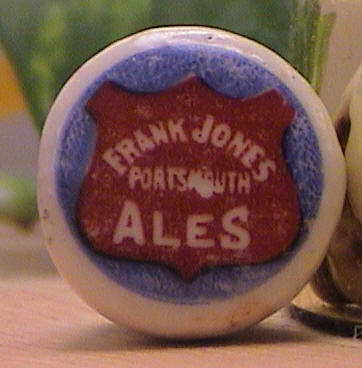 |
Frank Jones
Franklin Jones was born in Barrington, New Hampshire in 1832. He was the fifth of six boys as well as the fifth of seven children in his family. He left home at 16 and moved to Portsmouth and worked as an apprentice in his older brother Hiram's stove store. Within 3 years he owned an interest in the store and in 1854 he took it over completely. Throughout his life Jones would be active in several businesses at once, a pattern he developed early and in these early years he was also a tin peddler and a rag picker. In 1858 he became partners with John Swindell, an Englishman who had recently moved to Portsmouth to start a brewery producing ale.Jones' partnership with Swindell only lasted a few months before Jones owned the entire business including the property and, apparently, the recipe for ale that Swindell was using. A somewhat more ribald story held that Jones, a notorious ladies man, got the recipe for his ale from a housewife he seduced while working as a tin peddler. However he acquired it, Jones's ale would be a successful and popular product until 1950. Swindell did not do as well. After selling out to Jones he opened another brewery which was not very successful. He died in 1864 when he was hit by a train while pushing a little girl out of its path.
Frank Jones Brewing
By the time of the Civil War the Frank Jones Brewery was operating profitably and competing with one main rival, the Eldridge Brewing Company founded in Portsmouth in 1864 by Herman Eldridge. The two companies kept up their rivalry until Prohibition. Local Prohibitionist sympathies were strong, but the two breweries had steady business. They even held their own against the many ale-producing breweries in Albany, New York and Boston.
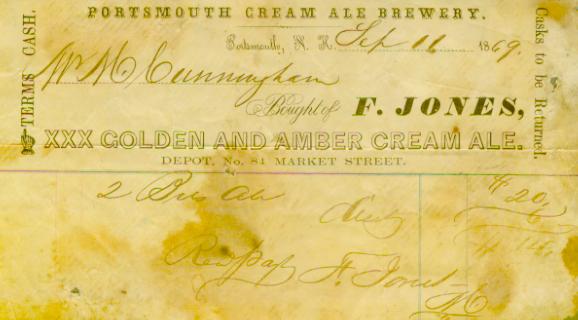 |
1869 Frank Jones bill, from the author's collection. |
Jones continually expanded his brewery as the centerpiece of his many businesses. The Portsmouth Chronicle published lengthy description of Jones brewery. Ironically, the paper's publisher, Frank Miller, although a friend of Jones, was also a prohibitionist.
"In connection with this brewery, Mr. Jones has, within a year or two, erected a large building for a malt house, and here the process of brewing (malting) commences. In the bins, lay immense piles of pure Canada barley, 25,000 to 33,000 bushels, certainly, 'good looking enough to eat as ale does to drink after the batch is made. About 500 bushels of grain is thrown into the great circular wooden water tank, the sides of which are higher than your head, located in the lower room, and soaked for a couple of days. Then, having been winnowed of all bad kernels, peas, other grains, weed seeds, etc., by dipping off these extraneous matters, which all float on the top of the water, and which are sold at a price for light food for horses, and for pigs, hens and etc. ... - the soaked and perfect barley are spread on the smooth, clean floor to the depth of six inches or so, and there lies for a few days to swell and sprout, heat and ferment. There are three of these piles or beds of barley, of 500 bushels each, spread over the floor, in different stages of preparation.
"From here the grain goes into the drying room, the floor of which is iron, punctured with innumerable little holes, like a strainer or sieve, and the coal fires in the furnaces which are never allowed to go out, day or night, the year round. When entirely dry, the grain, which is now malt, or malted barley, is conveyed to the brewery proper, and cracked in a mill, then soaked again, this time in hot water, pure from the Portsmouth Aqueduct, and placed on another sieve or strainer, and the liquid caught below, which, as extract of barley, is all of the grain which is wanted. The residue is the "Brewers Grain" which is sold for food for animals, and is a valuable manure.
"Hops are now added to this liquid extract in such quantities as to produce ale of desired strength and quality, whether stock, amber or cream; and, after fermenting to the proper point, is barreled for use. In pure ale there is no other ingredient besides these, water and hops. But adulteration by means of "quassis" (the wooden bark of tropical trees) instead of hops, may be made at greatly reduced prices. .. . We understand that Mr. Jones" accommodations, spacious and complete as they are, are by no means sufficient for his increasing business; and he has extensive stables and sheds already in the course of erection, and contemplates considerable additions to his brewery and malt house."
(there is no date listed for this quote in Brighton, King of the Ale makers, 39-40, but it was probably written about 1865.)
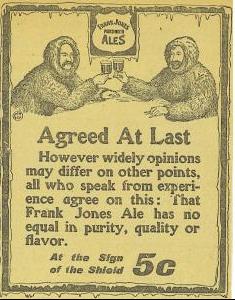 |
Frank Jones ad, pre-1900.
Jones continued to expand and modernize his brewery over the years. In 1878 Jones added a cooperage (barrel house) and the next year added a second malt house to his brewery. At about the same time Jones bought part partnership of a second brewery in Boston to make ale. In 1883 "The Western Brewer" (a brewer's trade journal) listed Frank Jones as the largest ale brewer in the country: they had brewed almost 150,000 barrels of ale in 1882. As a result of his increasing demand, Jones begins to develop local springs as a water supply. In 1884 the brew-house was expanded and in 1888 the "Clock Tower" is finished at the brewery. It was 140 feet high, 40 feet taller than the rest of the brewery. The clock face measured 11 feet across and the tower bell weighed over 3,000 lbs. By that time Jones employed over 500 men at his brewery, which probably made him the largest employer in Portsmouth. In 1890 the brewery added a large bottling shop.
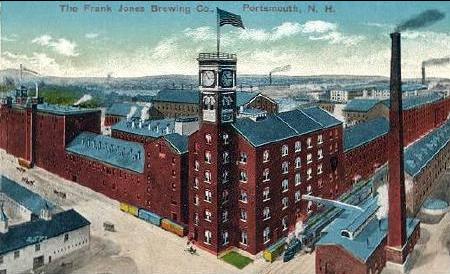 |
Frank Jones Brewery, two postcards from the author's collection.
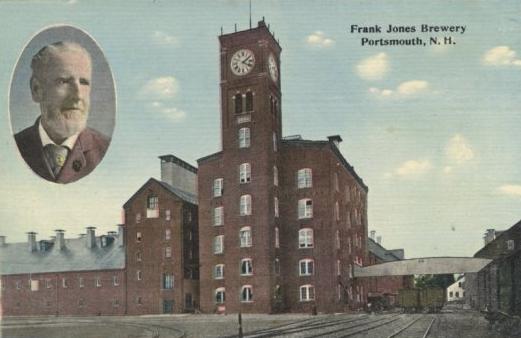 |
Expansion in Boston
Frank Jones ales were so popular that in 1889 he opened a branch office in Boston. In 1875 Jones and his son-in-law and business partner Sinclair together with two other investors bought the Henry Souther & Company brewery in South Boston for $150,000. The Boston brewery then had the capacity to produce 650 barrels a day, a rate which greatly increased over the years. Jones put his brother True W. Jones to run the Boston branch. When one of Jones' business partners sold out the brewery was renamed the Bay State Brewery. The Boston brewery continued operation until 1905.Politician 1867-1900
Frank Jones ran for Mayor of Portsmouth in 1867. Only 35 years old at the time, it was a bad time to be a Democrat in Republican New Hampshire, only two years after the Civil War. A local city directory even put a "C" for "Copperhead" next to the names of local residents who were southern sympathizers. Jones' campaign made certain to register new voters, particularly in the heavily Irish industrial area around his brewery. Residency requirements were far less settled in 1867 than today, in many areas (both Democratic and Republican) one only had to declare that they intended to become a US citizen in order to vote.
Jones took advantage of his status as both a local industrialist and in his outsider status to Portsmouth society since brewers not considered to be among the "best sort" of industrialist. He won election by a vote of 1,050 to 1,0001. Local papers hostile to Jones said he owned his election to Portsmouth's "Rumocracy", i.e. mainly Catholic Irish voters. In response to Jones' election, the Republican-controlled City Council stripped the mayor's office of much of its power. Jones managed to make effective use of what was left of his official authority however, and won reelection in 1868. The Republican City Council even passed a resolution thanking Jones for his capable leadership. In 1869 he was nominated for a third term. However, Jones was in the midst of a feud with the state Democratic Party and refused to campaign, purposely losing the election. He donated his salary for both of his terms to local schools and libraries.
After leaving the mayor's office, Jones continued to build up both his business and his standing in the New Hampshire Democratic Party. He attended the 1872 Democratic Convention in Baltimore when the Democratic Party formed a coalition with liberal reform Republicans and nominated newspaper editor Horace Greeley to oppose Ulysses Grant's reelection. Grant won, taking New Hampshire easily. Jones had cemented his ties with New Hampshire Democrats however, and in 1874 ran for Congress. During the Congressional election the local Republican party attacked Jones for his business making ale, and for his ties to the local Catholic establishment (even though Jones was Protestant.). Despite this, when the election was held in February 1875 Jones won easily in New Hampshire. At the time, with the exception of some federal offices, all voting was held on an annual basis with local elections in the Fall and state elections in the Spring.
Jones' record in Congress was not especially distinguished. He was assigned to the Naval Affairs Committee, appropriate for a representative from a port city. He served on a special subcommittee to investigate the Portsmouth naval yard, which found that several contractors owned the government a considerable amount of money. The subcommittee recommend that further payment be stopped on the contracts until the delinquent contractors satisfied their obligations. Jones was reelected in 1876.
Jones was most famous in Washington for his large home and his exceptional teams of horses as well as for his dilemma in voting on what were called "sound money" issues involving currency. As a wealthy businessman he supported "tight" currency which held inflation down. However, the Democratic Party at the time supported loosening restrictions on currency to increase the supply, thus making it easier for workers and farmers to pay their bills. Jones not only often voted against his own party on this issue but later even switched to the Republicans rather than back William Jennings Bryan's 1896 16-1 silver campaign.
Jones refused to run for a third term in 1878. His wife hated Washington and refused to stay there any longer. It wasn't until after Jones' death in 1902 that the public learned that Jones had taken a mistress in Washington and that Mrs. Jones wanted to get her husband away from the woman, who was, coincidentally, the daughter of another New Hampshire politician. In 1880 Jones ran for the New Hampshire governorship. He easily carried Portsmouth, but still lost the election to Charles Henry Bell of Chester, New Hampshire who was a prohibition supporter.
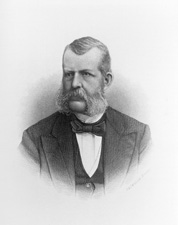 Governor C. H. Bell
Governor C. H. Bell
That ended his political career as a candidate but not as a political force in the state. He campaigned actively in 1884 for Grover Cleveland and made substantial financial donations to Cleveland's campaign. Cleveland's opponent, Maine's James G. Blaine, carried New Hampshire easily, 51% to 46 % in a losing effort as the Democrat won. President-elect Cleveland offered Jones the position of Secretary of the Navy, but Jones turned it down, his wife still refusing to go back to Washington. As one of the leading Democrats in New Hampshire, however, Jones was besieged by office-seekers asking for his help in obtaining a federal job from Cleveland. Jones would sometimes leave town at least in part to get away from the office-seekers hoping to win his influence on their behalf. He also used his ties with the President to make certain that the Portsmouth naval yard stayed open with work to do. In 1888 Jones lead the New Hampshire Democratic delegation to the Democratic Convention in St. Louis and once again spread a big "Cleveland for President" banner across the front of his brewery. Cleveland lost in 1888 despite winning the popular vote, but won the office back in 1892, again with Jones' support. Cleveland, however, lost New Hampshire all 3 times.
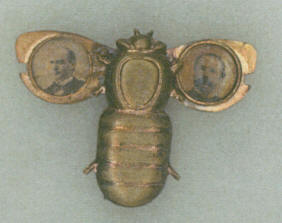
A "Gold Bug" pin from 1896. Thank to the Tony Atkiss collection.
In 1896 Jones became a "Gold Bug", as the Democratic opponents to William Jennings Bryan were known. Bryan had won the Democratic nomination for President that year campaigning on a 16-1 silver platform. According to the "Free Silver" advocates, the unlimited coinage of silver would expand the money supply and raise farm prices. Jones, who owned not only the huge brewery. He was also the president of the Boston & Maine Railroad and owned the Granite State Fire Insurance Company, the Portsmouth Fire Association, the Portsmouth Shoe Company; and two exclusive hotels, the Rockingham in Portsmouth and the Wentworth in Newcastle. With all those financial interests, Jones was not interested in making money cheaper. Jones told a local reporter "I have voted the Democratic ticket all my life, since I became a voter. But my right hand shall wither before I cast my ballot (for Bryan.)" Jones' switch was so complete that in 1897 he was considered for the Republican nomination for Governor. In 1900 he backed William McKinley against Bryan again.
Selling to the British
In the 1890s British financial interests began buying American breweries. The 1880s had been a time of expansion for many brewers in the US. When a major depression started in 1893 many brewers found themselves in severe debt. Moreover, the growth in the number of breweries meant that there was more production capacity than demand. As a result, breweries had started to consolidate even before the depression began. In the meantime, stock offerings in European breweries had all been purchased already and British investors were looking for a new outlet. As the Western Brewer noted...
[The British] are tired of investments in oriental bonds, African mining stock, colonical (sic) promotional organizations, etc. There is no money in those affairs, and they are quite risky. Hence American securities attract large attention. But British speculators will not invest in American railroad stocks...nor will they invest in mining stock....American brewery stock is a more stable commodity. (quoted in Baron, Brewed in America 269)
British investors began buying American breweries in the 1880s and when a depression started in the United States in 1893 and brewers began to fall into financial trouble, British investors stepped in even more. A number of the investors would buy all or most of the breweries in a single area, often paying well over market value to corner the market. The buyers would then combine the breweries into one company. Such trusts operated in Baltimore, Chicago, Detroit, Boston, Philadelphia as well as in other cites. Efforts to buy some of the biggest concerns such as Anheuser-Busch, Schlitz and Pabst were rebuffed, however. However, many investors had overpaid for their property. Consumption of beer dropped in 1894 and 1895 due to the depression and the resulting beer price wars in many areas dropped the price of beer drastically. In Chicago, for example, the price per barrel went from $6.00 to $3.50. When the beer tax increased to $2.00 in 1898 to pay for the Spanish-American war over-extended investors began to sell. Finally, the attempted concentration of breweries had meet with resistance from some local brewers and new, independently owned breweries began to be formed to compete with the conglomerates.
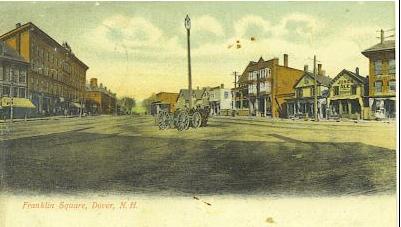 |
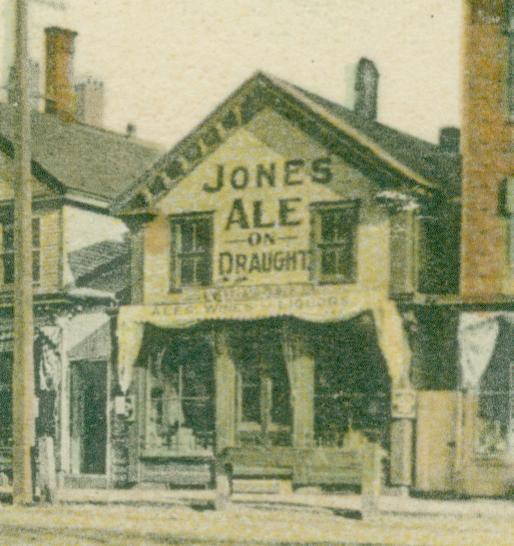 |
Dover NH, 1906. Note the Jones Ale sign on the building at left. Detail from the Dover, NH postcard.
Jones' sale came at the start of this wave of purchases and was a sign of what would be coming. He sold his two breweries for $6,300,00 of which between two and three million was "foreign capital." He got about 6% in cash and the rest in stock and bonds which were then sold on the British stock market. Jones kept about $500,000 in stock and he remained on the brewer's board of directors so in effect he remained in charge. The British directors were William Heygate, a director of the Middleton Railway, and English brewers E. Ind and R. Pryor. Jones and his business partner son in law Sinclair made about four million dollars in profit. Jones guaranteed a 15% net annual profit for three years to the buyers.
There was some local discussion of what British control over such a prominent business would mean to Portsmouth but Jones assured the city that he would remain in control. A local newspaper under the control of one of Smith's Republican rivals charged that he was selling his brewery to the British in order to buy out the Boston & Maine railroad. Jones in fact did become President of the B&M Railroad in 1889, but he had already been on the board of directors. Sale of the brewery, however, undoubtedly did give him more resources for expanding his other businesses including his railroad stock.
The brewery of course continued after Jones died in 1902. In 1903 the Boston plant was closed. The main brewery in Portsmouth, however, continued brewing ale until Prohibition began in New Hampshire in 1917.
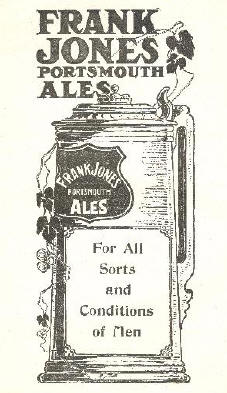 |
Frank Jones advertisement from a 1906 theater program.
Jones also owned many other businesses in New Hampshire. In 1884 a fire destroyed Rockingham House. When the insurance company balked at paying the full amount Jones convinced the New Hampshire legislature in 1885 to pass a law requiring insurance companies to fully cover their policies on buildings. In an attempt to force New Hampshire to back down, fifty-eight insurance companies withdrew their business from the state. Instead of forcing the state to reconsider, this provided and opening for local businessmen to form their own companies, including Jones. He and fourteen others founded their own firms, some as a temporary measure, some as permanent companies. Jones' company, The Granite State Fire Insurance, stayed in business after the out of state firms returned to the state.
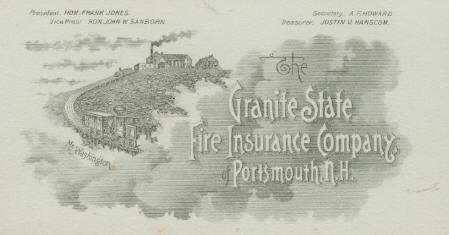 |
Granite State Insurance Company blotter.
Among Jones' other businesses
- the Portsmouth Shoe Company (founder)
- the Morley Button Manufacturing Company, a shoe button factory (founder)
- Portsmouth and Dover Railroad (only 10 miles long) (founder?)
- Boston & Maine Railroad (Director)
- Portsmouth Trust and Guarantee Company (founder)
- New Hampshire National Bank of Portsmouth (Director)
- Director of a bank in Nashua
- Director of a bank in Lancaster
- Director of a bank in Wolfeboro
- American Woolen Company (Director)
- Providence Mill Company (Director)
- Worcester Mill Company (Director)
- Union Publishing Company (Director)
- Portland, Mt. Desert & Machias Steamship Company (Director)
- New Hampshire Fire Insurance Company (Director)
Utilities - Rockingham Power & Light Company (Portsmouth)
- Electrical utility in Sorrento
- Electrical utility in Tavares, Florida.
Hotels, Restaurants, etc.
- Wentworth Hotel (New Castle) 1879-1902
- Rockingham House (Portsmouth) (1870-1902, rebuilt 1884-1889)
- Sorrento House (Frenchman's Bay, Maine)
- The Revere House (Boston)
- The Quincy House (Boston)
- The Boston Tavern
- Osceola House (Tavares, Florida)
- Granite Park Trotting Park. (Dover, NH) 1896-1902
- Portsmouth Music Hall (1901-1902)
Newspapers - Portsmouth Daily Evening Times (owned about 5 years)
- Portsmouth States and Union (weekly)
The Frank Jones was a coastal steam ship built to carry passengers and freight along the North Atlantic coast. Built in 1892 at the Bath Iron Works in Bath, Maine.
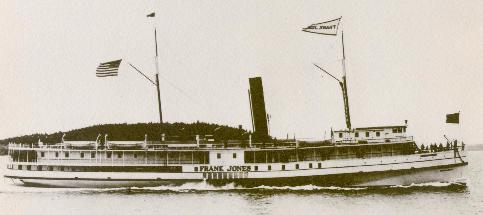 |
The Frank Jones. (photo from author's collection) |
Post-Prohibition
The Frank Jones Brewery never reopened after Prohibition. Its equipment was sold off: the Heuther Brewing Company in Ontario bought the bottling equipment. But the brand was reborn when Prohibition ended. Ironically, it was produced by the Eldridge Brewing Company of Portsmouth, Jones' old rival. From 1933 to 1937 the Eldridge Brewing Company brewed ale in the old Frank Jones plant under the Eldridge name. In 1937 it renamed itself the Frank Jones Brewing Company. Originally their ale was called Eldridge Portsmouth Ale. However, just to continue the confusion, it was brewed with the old Frank Jones formula! In 1937 the ale was also renamed Frank Jones Ale.
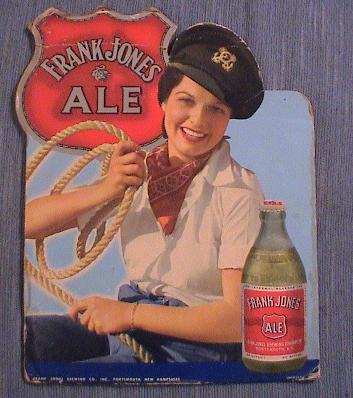 |
A 1940s Frank Jones sign.
Closing
In 1947 the brewery was sold to Caldwell, Inc. another New Hampshire company, one which distilled rum. (This is a different company from the present Caldwell, Inc. which manufactures things such as pallet lifters.) Consumers' tastes were changing, however. Prior to World War II New England and upper New York state were the last holdouts to prefer ale to lager beer. After the war, however, lager beer gained favor in the Northeast and Frank Jones continued losing sales. In 1950 the brewery closed. Some of the buildings still stand in Portsmouth, however, used as offices and shops.
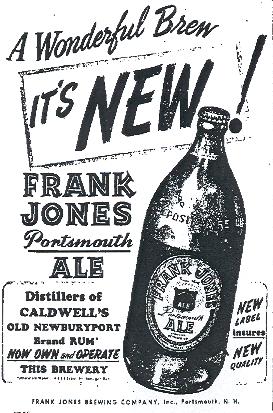 |
1947 Frank Jones newspaper ad, note the new owners.
Timeline
1832 15 September Jones born on a farm in Barrington, New Hampshire.1858 Jones is working for John Swindell at his brewery.
1860 Jones is full owner of the brewery which produces 5,300 barrels a year.
1863 Jones adds a malt house to brewery.
1868 Elected Mayor of Portsmouth.
1874 Elected to the 47th Congress as a Democrat.
1876 Re-elected to Congress as a Democrat.
1878 Does not run for re-election to Congress.
1878 Jones adds a cooperage (barrel house) to his brewery.
1879 Jones adds a second malt house to his brewery.
1880 Jones loses New Hampshire governor's race to Republican Charles Henry Bell by only a few thousand votes, 44,432 to 40,813.
1883 "The Western Brewer" (A trade journal) lists Frank Jones as the largest ale brewer in the country. In 1882 the brewery produced almost 150,000 barrels of ale.
1883 Jones begins to develop local springs as a water supply. He either founds or buys the Portsmouth Aqueduct Company.
1884 The brewery house is expanded.
1888 The "Clock Tower" is finished at the brewery. It is 140 feet high, 40 feet taller than the rest of the brewery. The clock face measured 11 feet across. The tower bell weighed over 3,000 lbs.
1889 16 March Frank Jones puts his company's stock on the market in London. The new company is incorporated on 17 May 1889 with Jones remaining to manage the plant.
1896 Disgusted over William Jennings Bryan's stand on "Free Silver", Jones switches to the Republican party.
1896 The Portsmouth brewery is producing about 250,000 barrels a year.
1900 Presidential Elector to the Republican ticket, William McKinley and Theodore Roosevelt.
1900 Bottling works added.
1902 2 October Jones dies at his home in Portsmouth.
1917 Prohibition starts in New Hampshire as a war-time measure.
1933 Prohibition ends in New Hampshire.
1947 June 3. Frank Jones Brewery sold to Caldwell, Inc.
1950 Frank Jones brewery closes after 90 years.
Brands Produced by Frank Jones Brewery
(additions and corrections welcome!)India Pale Ale
Homestead Ale
Nourishing Stout
Golden Ale (just prior to Prohibition)
Frank Jones Ale (post Prohibition)
Frank Jones Bock (post Prohibition)
Name Changes
John Swindells 1856-1858Swindells and Jones 1858-1859
Frank Jones 1859-1888
Frank Jones Brewing Co., Ltd. 1888-1917
Eldridge Brewing 1933-1937
Eldridge Brewing Co. 1937-1943 dba Frank Jones Brewing Co.
Frank Jones Brewing Co. 1943-1950
Sources
Anderson, Will. Beer New England (Portland, Maine: 1988) 68-74, 147.
Baron, Stanley. Brewed in America: A History of Beer and Ale in the United States (North Stratford, NH: Ayer 2002) reprint of 1962 edition.
Brighton, Ray Frank Jones: King of the Ale makers (Hampton, New Hampshire: Peter Randall, 1976)
"Jones Bottling Equipment Sold to Canadian Company" Portsmouth Herald (April 20, 1927) 1.
"The Jones Brewery" Portsmouth Journal of Literature and Politics. (January 31, 1910) 5. Has the details of the sale of Jones' breweries.
Lalor, John, Cyclopedia of Political Science, Political Economy, and the Political History of the United States by the Best American and European Writers (1881) has a good summary of New Hampshire political history written in Jones' time.
Robinson, J. Dennis. "Tapping Old Spirits at Frank Jones Brewery" SeacoastNH.com
 A special Thank You to Nicole Cloutier, Special Collection Librarian at the Portsmouth Public Library for her help!
A special Thank You to Nicole Cloutier, Special Collection Librarian at the Portsmouth Public Library for her help!
For more information visit the Portsmouth Athenaeum website!
